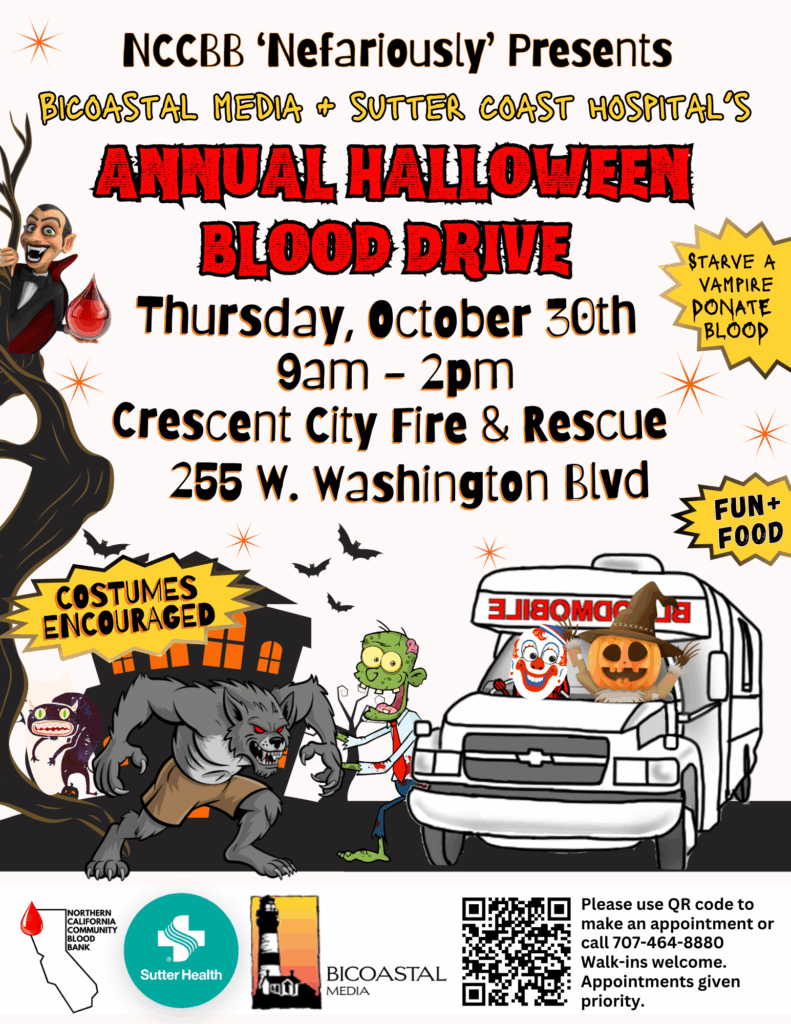
The strength of our community blood supply is dependent on local donors, businesses, and organizations that donate and sponsor blood drives with NCCBB.
What’s so important about donating blood?
- A continuous supply of blood is essential to meet the needs of patients in area hospitals, and a steady stream of donors is necessary to meet that need. Blood is only available through the generosity of volunteer donors.
- It is estimated that 95% of the population will use blood or a blood component by the age of 75 – unfortunately, less than 5% of the eligible population actually donates.
- Someone needs blood every two seconds.
- 1 out of 7 people entering the hospital will need blood.
- Up to 3 lives are saved by one pint of donated blood.
- The average transfusion patient receives 3 units of red blood cells.
- The shelf life of donated red blood cells is 42 days.
- The shelf life of donated platelets is five days.
Who can donate? Basic eligibility:
- Age: Usually 17+ (16 with parental consent in some places)
- Weight: At least 110 lbs
- Health: Must be in good health
- You can donate whole blood every 56 days (8 weeks).
- Platelet donation is possible every 7 days, up to 24 times a year.
How much blood is drawn? Is it safe for my body to lose that much blood?
- One pint. The average person has 10-12 pints, so the small loss is easily afforded.
- The fluid (plasma) is replaced within 24 hours. The red cells take about five weeks.
Who needs blood transfusions?
- A wide variety of patients receive blood transfusions. The various components of donated blood are used to treat different conditions. For example, red blood cells are transfused to patients who have lost blood due to trauma or surgery, and to treat anemia (including sickle cell anemia). Cancer patients need platelet transfusions to replace the healthy cells that are destroyed during chemotherapy and radiation. Burn victims often need plasma transfusions to treat them for shock.
- Red blood cells carry oxygen to the body’s organs and tissue.
- Platelets support blood clotting
- 5 million American lives are saved each year by blood transfusions.
- Bone marrow transplant patients can use up to 120 platelets and red blood cells from about 20 people.
- Severe burn victims may need 20 units of platelets during their treatment.
- Car accident and blood loss victims may need transfusions of 50 pints or more of red blood cells.
How Blood is Used
- Red blood cells: These are used to treat anemia, blood loss, and other conditions where there’s a need to increase red blood cell count.
- Platelets: Platelets help blood clot. They are often given to cancer patients, people with bleeding disorders, and those undergoing surgery.
- Plasma: Plasma is the liquid component of blood and contains vital proteins, electrolytes, and hormones. It’s often used to treat burns, liver disease, or clotting disorders.
- Cryoprecipitate: This blood product contains clotting factors and is used to treat bleeding disorders, particularly in hemophilia patients.
Is donating blood safe?
- Blood donation conditions are sanitary, and needles are sterile and disposable.
How will I feel after donating? What activities can I do after my donation?
- Most donors feel fine after donating. Remember to eat a healthy meal afterwards and drink plenty of fluids. You can continue your normal routine but avoid heavy lifting and strenuous exercise for 12 hours.
What are the major blood types?
- A, B, AB and O are the four main types of blood types. AB is the universal recipient; O negative is the universal donor.
- Type 0- blood is especially valuable as it can be given to patients with any blood type, making it crucial in emergencies.
- About 45% of people in the U.S. have type 0 blood making it the most common.
- Blood centers often run short of type O blood.
- Your blood type is determined by the antigens it contains. There are two major types of blood antigens: ABO and Rh, which combine to create blood types: O+. O-, A+, A-, B+, B-, AB+ & AB-.
Who can receive my blood?
- A patient can receive blood that has the same ABO antigens as theirs, plus O. Rh+ can receive Rh+ or Rh-, while Rh- must receive Rh- blood.
How much does your donation help?
- Automobile Accidents: Up to 50 red blood cell units
- Cancer Patients: Up to eight platelet units per week
- Heart Surgery: Up to six red blood cell units + six platelet units
- Organ Transplants: Up to 25 plasma units + 30 platelet units + 40 red blood cell units
- Burn Victims: Up to 20 plasma units
- Premature Infants: Up to five units of red blood cells
Did you know?
- Someone needs blood every two seconds.
- Less than 10% of the eligible U.S. population (38%) donates annually.
- There is no substitute for human blood.
- One in seven people entering a hospital need blood.
- Females receive 53 percent of blood transfusions. Males receive 47 percent.
- One unit of blood can be separated into several components: red blood cells, plasma and platelets.
- Fifteen tests (eleven for infectious diseases) are performed on each unit of donated blood.
- Healthy adults who are 16 years old and weigh at least 110 pounds are eligible to donate whole blood.
Giving blood is easy just to show up and let the donor care specialist handle the rest.
That said, it’s helpful to familiarize yourself with some important guidelines beforehand to feel more confident and prepared for the process. There are also a few things you should consider before donating blood. Here are four keys to a successful donation:
- Don’t donate if you’re feeling unwell. Donating blood when you’re sick isn’t helpful — not only can you spread germs, but the donation center would also turn you away. Make sure you’re feeling healthy and symptom-free before you donate.
- Don’t smoke or drink alcohol before donating. Smoking can reduce your blood’s ability to carry oxygen, so try to hold off for at least two hours before your donation. Alcohol, on the other hand, causes dehydration, so it’s best to avoid for 24 hours before giving blood. Your future self will thank you!
- Don’t stay up too late. Aim for 7-8 hours of sleep the night before your appointment. Being sleep-deprived could leave you feeling groggy during the donation, so skip the late nights and rest up!
- Before you donate: Eat a well-balanced meal, free of fatty or fried foods. A diet that regularly includes iron-rich foods will help promote red cell regeneration, increasing your chances of having an adequate hemoglobin levelfor blood donation, make sure to drink extra water, and wear comfy clothes and you’ll feel great.
Conclusion
Donating blood is a simple yet powerful way to make a significant difference in the lives of
others. It not only helps those in need but also offers health benefits to the donors
themselves. If you’re eligible, consider becoming a regular donor to help meet the ongoing demand for blood.
Preparing for your first blood donation can help you feel more comfortable and ensure a smooth experience. Here are some practical steps to get ready:
The Day Before
- Hydrate well: Drink plenty of water the day before and the morning of your donation. Aim for at least 8–10 glasses of water.
- Eat balanced meals: Have iron-rich foods (like lean red meat, beans, lentils, spinach, or fortified cereals) to keep your hemoglobin healthy.
- Get a good night’s sleep: Rest helps keep your body strong and your blood pressure stable.
The Day Of Your Donation
- Eat a hearty meal beforehand: Don’t donate on an empty stomach. Include protein and complex carbs (like eggs and whole grains) and avoid fatty or greasy foods, which can affect blood testing.
- Drink extra fluids: Water or juice is best; avoid alcohol for 24 hours and limit caffeine, which can dehydrate you.
- Wear comfortable clothing: Short sleeves or sleeves you can roll up easily will make it easier to access your arm.
What to Bring
- Photo ID (driver’s license, student ID, etc.).
- A list of medications if you take any.
- A positive mindset—it’s normal to feel a little nervous!
After You Donate
- Stay for snacks and juice to replenish your fluids and sugar.
- Keep drinking water for the next 24 hours.
- Avoid heavy exercise or lifting for the rest of the day.
- Leave the bandage on for a few hours to prevent bleeding or bruising.









